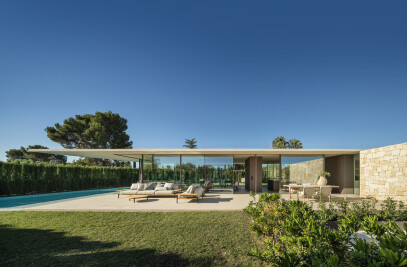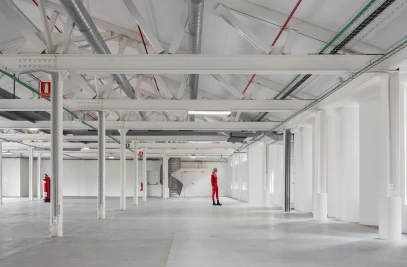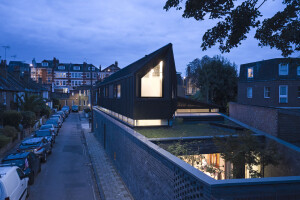Depending on your viewpoint, a huge conservatory expands the young family's living space – or it gives the garden a roof, for relaxed moments together even on rainy autumn evenings. The new construction is also pretty impressive in terms of energy efficiency: the building, which complies with the German energy standards of a KfW Efficiency House 70 and is fitted with PV modules on the roof, a ground source heat pump with surface collectors, and solid insulation, consumes about as much electricity as it generates, in total. In addition, all the home technology components are linked up and can be controlled via a smartphone or a tablet, and smart automatic functions make everyday life that little bit easier. The major advantage: with the basic installation, the family is perfectly equipped for the future, as solutions can be easily integrated and programmed at any time.
It was important to the property owners that the office and utility room as well as the living room and kitchen were at ground level, so that family members could spend as much time as possible together. In the centre of the living area there is a huge wooden table, which seats 10 people. Large glass façades bring light into the house, which is hidden from view due to its position behind a grassy mound. The spacious conservatory that can be opened with sliding glass doors evolved from the original idea of a roofed-over terrace. The house also appears capacious and airy – due to the room height of 2.85 metres and above all, to the open ceiling space revealing the upper floor. An open staircase leads from the living area to the upper floor, where a gallery connects the individual rooms.
The house has a white, grey and black colour scheme, which runs through all the built-in components. Dark, easy-to-clean stone tiles, each measuring 80 x 40 cm, blend in with the white walls and furniture – and the dark, flamed granite slabs (Nero Assoluto) in the kitchen, bathrooms, and around the fireplace add a further accent. The wooden table, wicker sofa, and natural decorative materials such as wooden bowls, bark, driftwood and plants, provide warmth and a sense of cosiness, while the hallway is dominated by a stunning silver lamp made of wire mesh.
The property owners deliberately opted for an energy-efficient house: a solid, sand-lime brick construction with a 200 mm insulation layer made out of hard polystyrene foam. The windows are triple-glazed and the floor plate and roof have 250 mm and 240 mm of insulation respectively. All of which adds up to a home that can be classified as a KfW Efficiency House 70, under the 2009 German Energy Saving Ordinance (EnEV). A house like this has an annual energy consumption of only 70% of a comparable new build under the EnEV. In this case, only 65% is actually needed. As it wasn't possible to drill deep down for geothermal energy, the property owners opted for near-surface ground heat. To this end, so-called 'surface collectors' – compact, 1 x 8-metre mats – were laid down flat beneath the lawn.
Throughout the entire house, an intelligent infrastructure has been installed alongside the power supply lines: the KNX system links up all the electrical components and a Gira HomeServer acts as a central control unit. Even the heat pump and underfloor heating are incorporated. As a minimum flow rate per room has been programmed into the HomeServer, the floor can now act as buffer storage. This saves 2 degrees Kelvin of flow temperature, no additional buffer storage needs to be purchased, and in the winter, it's even a little bit warmer in the buffer rooms – the living/eating area and the bathrooms. This provides additional comfort and saves money too.
With regard to the building technology, the property owners consulted system integrator Klaus Geyer, who has been developing and implementing intelligent building concepts for many years. "With a new building, the important thing is to first get the basic infrastructure in place, i.e. to simultaneously install a KNX control line alongside the power line. Then, various basic functions are programmed, for example the lighting control and blinds, and other aspects such as the heating are incorporated into the system." The KNX system is not necessarily more expensive than a conventional electrical installation with electrical blind controller and single-room temperature control, as there is then no need to purchase and install heating controllers in every room, for example. The property owners were also able to do without expensive buffer storage. "And if the owners wish to programme in additional functions or add new components at a later date, that should go through without a hitch with the basic KNX installation," added Mr Geyer.
One of the basic functions is the lighting. Individual light sources are linked up to scenarios and can be conveniently called up at the press of a button, either using the Gira touch sensors on the wall or with a smartphone or tablet. But each individual light can also be operated separately, and most can be dimmed. The touch sensors are programmable switches, and the classic Gira E2 pure white switch range blends unobtrusively into the building's clean, straight lines. To make things simpler to operate, care was taken to ensure that the 'Light' function was always on the upper part of the button, so that visitors could also find their way around easily. Otherwise, icons are quick and simple to understand.
A central switch allows all of the blinds on a single level to be controlled at once, however it's also very easy to do this for each individual window using a tablet or smartphone. In rainy and/or windy weather, the blinds are automatically raised and the awning is retracted, with the corresponding warning delivered by the Gira weather station on the roof. Should the owners wish to, they can add another automatic function relating to the temperature and the elevation of the sun at a later stage, as the infrastructure is already in place.
The air conditioning system works like a heat exchanger – i.e. in winter, cold, fresh air is pre-heated, and in summer, warm air from outside is cooled down. All of the rooms are connected to the air conditioning system and no longer need to be manually ventilated: a practical, additional benefit, particularly for a newly built house whose inhabitants are working professionals. A photovoltaic system with 34 SunPower modules is installed on the roof, and has an overall output of 8.16 kWp. Some 20% of the power generated is consumed by the inhabitants of the house; the rest is fed into the grid. The circulation pump circuit for hot water is a significant energy saver: you simply press the relevant switch 1-2 minutes before taking a shower, the pump is activated, and hot water is pumped into the pipes. The pump shuts itself down again after half an hour. As hot water doesn't have to be constantly available in all the pipes, energy consumption drops automatically.
A music system distributes audio from central music sources throughout the entire house. By incorporating this into the KNX system, it can be operated via the Gira touch sensors on the wall, and also through mobile devices. One of the young couple's favourite switches is "Ground floor off": at the press of a button, the ground floor and terrace lights are extinguished, the music is turned off, the awning is retracted, and the projector screen is raised after a cosy movie night. This sort of living comfort is something that they never want to do without again. And the "Wake up" function is a relaxing way to start the day: the light slowly gets brighter over 10 minutes and the music gets louder.
The owners can get into their house simply and without a key using the Gira Keylessin fingerprint. Klaus Geyer has programmed another practical solution into the system here: each finger activates a different function. It sounds like a wacky idea, but is actually nothing of the sort. The index finger opens the front door, the middle finger opens the garage, and the ring finger opens the garage door. Even the Mobotix camera by the front door is used for several purposes: if motion is detected, the light is switched on, and if the bell is rung, a photo is automatically taken of the visitor.
Individual water cycles have been laid in the garden, and these are automatically performed if the watering function is activated on the smartphone or tablet. In the future, an automatic function might even be a possibility here: an irrigation cycle that starts intelligently, depending on the weather forecast and a precipitation radar.


































